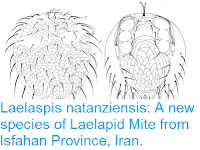Mites (Acari) are small Arachnids related to Harvestmen
(Opilones). They are one of the most
numerous and diverse Arthropod groups, with over 48 000 known species,
but are often overlooked due to their small size. Many Mites are
parasitic, with species targeting Insects, Vertebrates, Plants and even
Fungi. The earliest known fossil Mites are found in the Early
Devonian Rhynie Chert of Scotland, making them about 410 million years
old. The Eriophyoidea are a group of herbivorous mites, many Eriophyoid Mites cause plants to form galls (tissue growths which cover and protect the parasite), but others are free living. All Eriophyoid Mites show reduced leg numbers, with free living species having at most two pairs of legs, and gall-forming species only one. Like Mites as a whole, the Eriophyoidea is an ancient group, with the oldest known example coming from Late Triassic amber from Italy.
In a paper published in the journal ZooKeys on 9 May 2019, Samiran Chakrabarti of the Post-Graduate Department of Zoology at Vidyasagar College, Ramkrishna Pandit of the Department of Zoology at Mahadevananda Mahavidyalaya, and Surajit Sur, also of the Post-Graduate Department of Zoology at Vidyasagar College, describe a new species of Eriophyoid Mite from West Bengal State, India.
The new species is named Mesoshieldophyes varecae, where 'Mesoshieldophyes' meaning 'medium-shield-wool-grower' and 'varecae' refers to the host, the Asamese Honey-plant, Casearia vareca, a fruiting shrub in the Willow Family, widely distributed in eastern India, Bangladeah, Bhutan, and Myanmar. The species is described from 12 female mites, 120–145 μm in length, with a flattened spindle shape and two pairs of legs. The mites are yellow in colour and were found on the underside of leaves, where they caused no visible damage. The specimens were collected from a plant in the Bengdubi Forest in the Darjeeling District of West Bengal.
Mesoshieldophyes varecae, dorsal view. Chakrabarti et al. (2019).
See also...
Follow Sciency Thoughts on Facebook.







